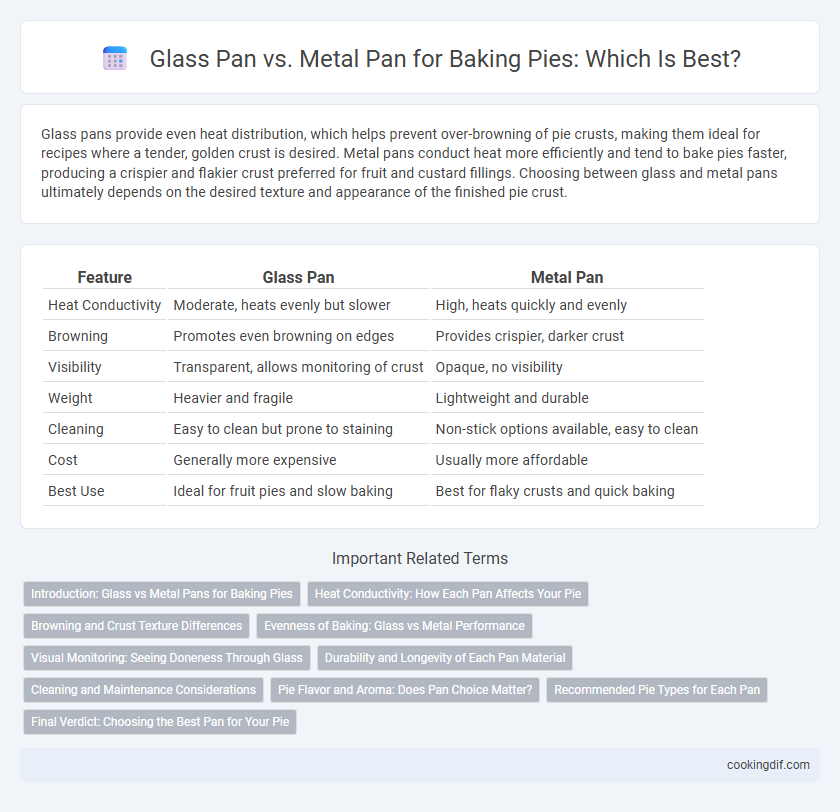Glass pans provide even heat distribution, which helps prevent over-browning of pie crusts, making them ideal for recipes where a tender, golden crust is desired. Metal pans conduct heat more efficiently and tend to bake pies faster, producing a crispier and flakier crust preferred for fruit and custard fillings. Choosing between glass and metal pans ultimately depends on the desired texture and appearance of the finished pie crust.
Table of Comparison
| Feature | Glass Pan | Metal Pan |
|---|---|---|
| Heat Conductivity | Moderate, heats evenly but slower | High, heats quickly and evenly |
| Browning | Promotes even browning on edges | Provides crispier, darker crust |
| Visibility | Transparent, allows monitoring of crust | Opaque, no visibility |
| Weight | Heavier and fragile | Lightweight and durable |
| Cleaning | Easy to clean but prone to staining | Non-stick options available, easy to clean |
| Cost | Generally more expensive | Usually more affordable |
| Best Use | Ideal for fruit pies and slow baking | Best for flaky crusts and quick baking |
Introduction: Glass vs Metal Pans for Baking Pies
Glass pans provide even heat distribution, which helps prevent hot spots and ensures thorough baking of pie crusts. Metal pans, particularly aluminum or steel, conduct heat faster, resulting in crisper, browner crusts ideal for fruit or custard pies. Choosing between glass and metal pans depends on the desired crust texture and baking time preferences.
Heat Conductivity: How Each Pan Affects Your Pie
Glass pans offer slower heat conductivity, resulting in more even baking and a gently browned crust, ideal for delicate pies that require steady heat. Metal pans, especially aluminum, conduct heat quickly, producing a crispier crust with a risk of over-browning if not monitored carefully. Choosing between glass and metal pans depends on the desired crust texture and baking precision for your pie.
Browning and Crust Texture Differences
Glass pans provide even heat distribution, resulting in slower browning but a more uniformly cooked crust, often yielding a crisp yet tender texture. Metal pans conduct heat more efficiently, promoting faster browning and a flakier, crunchier crust with pronounced golden edges. Preference depends on desired crust characteristics: glass pans suit softer, evenly baked crusts, while metal pans excel at creating crisp, deeply browned finishes.
Evenness of Baking: Glass vs Metal Performance
Glass pans provide more even heat distribution during pie baking, allowing the crust to brown uniformly and preventing hot spots. Metal pans, especially aluminum or steel, conduct heat faster, resulting in a crisper crust but potentially uneven baking if the heat is too high or inconsistent. For precise, consistent pie crust texture, glass pans are often preferred due to their steady thermal properties.
Visual Monitoring: Seeing Doneness Through Glass
Glass pans offer superior visual monitoring during pie baking by allowing bakers to clearly see crust browning and filling bubbling, which helps prevent over- or under-baking. Unlike metal pans that obstruct the view, transparent glass provides real-time insight into doneness without opening the oven door. This visibility enhances precision in achieving the perfect pie texture and color, crucial for flaky crusts and well-cooked fillings.
Durability and Longevity of Each Pan Material
Glass pans offer moderate durability with resistance to scratching and staining but may crack or shatter under extreme temperature changes, affecting their longevity. Metal pans, particularly those made of aluminized steel or heavy-gauge aluminum, provide superior durability and long-term use due to their robust construction and resistance to warping. Choosing metal pans can enhance the lifespan of baking equipment, while glass pans require careful handling to avoid damage over time.
Cleaning and Maintenance Considerations
Glass pans offer the advantage of non-porous surfaces that resist staining and odors, making them easier to clean after baking pies compared to metal pans. Metal pans, especially those without non-stick coatings, may require more effort to remove baked-on residue and can be prone to rust if not dried properly. Regular maintenance of metal pans involves thorough drying and occasional seasoning to prevent corrosion, while glass pans typically need only standard washing with mild detergent.
Pie Flavor and Aroma: Does Pan Choice Matter?
Glass pans retain heat evenly, allowing pies to develop a consistent golden crust that enhances the buttery flavor and rich aroma of fillings. Metal pans conduct heat more quickly, producing a crisper crust with slightly toasted notes that intensify the pie's overall taste profile. Choosing between glass and metal pans can subtly influence the balance of pie flavor and aroma, making pan selection a key factor for bakers seeking optimal sensory results.
Recommended Pie Types for Each Pan
Glass pans provide even heat distribution, making them ideal for fruit pies like apple, cherry, or blueberry, which benefit from a consistent bake and a well-caramelized crust. Metal pans, particularly aluminum or stainless steel, offer superior heat conduction, perfect for flaky, tender crusts found in custard, pumpkin, or pecan pies. Choosing the proper pan enhances texture and doneness, with glass well-suited for visual appeal and metal pans fostering a crispier crust.
Final Verdict: Choosing the Best Pan for Your Pie
Glass pans provide even heat distribution and allow you to monitor browning, ideal for transparent crusts and delicate fillings. Metal pans heat up faster and offer crispier, browner crusts, perfect for traditional pies requiring a flaky texture. The best pan choice depends on your desired crust texture and filling visibility, with glass favored for gentle baking and metal excelling in sharp, golden finishes.
Glass pan vs metal pan for baking pies Infographic

 cookingdif.com
cookingdif.com